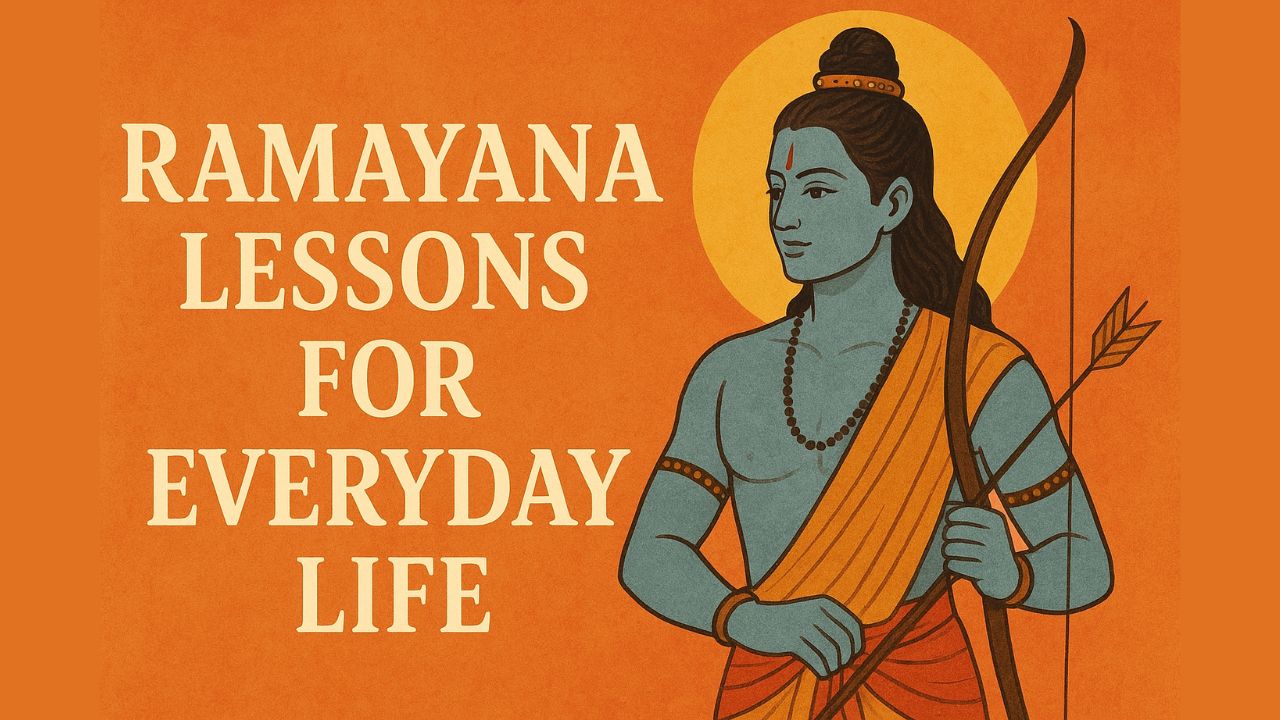
The Epic That Refuses to Fade
The Ramayana is not just a story preserved in ancient manuscripts; it is a living tradition that continues to shape millions of people’s moral and cultural framework. Passed down for generations, it has been expressed in temple carvings, folk songs, television serials, and even contemporary films. But its enduring power lies in how it speaks to human dilemmas that are as real today as they were thousands of years ago.
When we look closer, the epic is not just about gods, demons, or kings but about the struggles of ordinary human life. The tension between duty and desire, the courage to uphold integrity, the strength to walk away with dignity, the dangers of unchecked ambition, all of these are dilemmas modern people face in workplaces, relationships, and personal journeys. This is why the Ramayana is not a relic of the past but a mirror held up to our present lives.
Rama and the Weight of Duty
One of the epic’s most important teachings is perhaps Rama’s acceptance of exile. Instead of contesting his father’s word or prioritizing his rightful claim to the throne, Rama chose to honor the promise made by King Dasharatha. This choice was not made out of mindless obedience, but rather an awareness that a kingdom’s stability depends on honesty, integrity, and faith in one’s own word.
In our own world, this resonates with leaders and individuals who must often choose between short-term gains and long-term credibility. Politicians who refuse to bend ethical codes, corporate leaders who step down to maintain accountability, or even students who avoid shortcuts in examinations, all reflect Rama’s spirit of upholding values despite personal loss. True responsibility, as the epic teaches, sometimes demands sacrifice of comfort and ambition for the sake of trust and harmony.
Sita’s Resilience and Autonomy
Sita’s path reveals a person of remarkable endurance and individuality, yet her tale is too frequently limited to the cliché of a devoted wife. She voluntarily walked into exile, endured separation with quiet strength, and never once allowed her dignity to be diminished by Ravana’s threats. Even in captivity, her refusal to yield was not an act of passive waiting but an active assertion of her willpower.
Her final act of choosing to leave Rama’s court and return to Mother Earth is perhaps the strongest declaration of independence in the epic. Sita reminds us that resilience is not about enduring pain silently; it is about holding on to one’s dignity, even if it means taking the difficult road of walking away. In today’s world, where individuals, especially women, are often pressured into silence or compromise, Sita’s voice echoes as a reminder that self-respect is non-negotiable.
Lakshmana’s Loyalty and the Lesson of Boundaries
Lakshmana embodies loyalty taken to its highest form. He gave up royal comforts to accompany Rama and Sita into exile, and his vigilance never faltered. Yet, the “Lakshmana Rekha“, the protective boundary he drew around Sita’s dwelling, has become one of the most enduring metaphors of the epic.
This Rekha was not about control but about safety and respect for limits. In our relationships today, whether personal or professional, this lesson holds immense relevance. Loyalty and concern should never equate to dominance or suffocation. In friendships, partnerships, and workplaces, healthy boundaries preserve respect while allowing support. Lakshmana’s example shows that loyalty without balance can become unhealthy, but loyalty with boundaries nurtures trust and harmony.
Hanuman's Strength in Service
Hanuman stands out as the symbol of unshakeable devotion and strength combined with humility. His legendary leap across the ocean was not merely a physical feat but the result of unwavering faith in his mission and in Lord Rama. Unlike many heroes, Hanuman’s greatness was never about personal glory. Every act of courage he performed was grounded in service.
In today’s context, Hanuman’s spirit is seen in professionals who dedicate themselves to causes greater than themselves, teachers shaping futures, social workers serving marginalized communities, or even quiet team members in organizations who ensure success without demanding the spotlight. True greatness, as Hanuman shows, often emerges not from self-promotion but from selfless service.
Ravana: The Complex Villain
Despite being frequently vilified, Ravana is one of the most nuanced figures in Indian mythology. A scholar, a musician, a ruler, his talents were undeniable. However, unbridled passion and ego were the cause of his collapse. He was destroyed because he was unable to manage his passion with Sita, which obscured his knowledge.
In modern times, Ravana mirrors individuals who, despite brilliance, let arrogance and unchecked ambition consume them. We see echoes of Ravana in corporate scandals, political downfalls, and even personal relationships destroyed by pride. His story is a cautionary tale: intelligence and power, when not tempered by humility, can become one’s greatest enemies.
The Forest: A Place of Transformation
Exile in the forest is often viewed as a punishment, but in the Ramayana, it is also portrayed as a period of profound growth and transformation. Stripped of luxuries and palace comforts, Rama, Sita, and Lakshmana discovered resilience, adaptability, and strength. The forest became a crucible that prepared them for the greater challenges ahead.
In today’s life, we all face “forest phases“, times of transition, uncertainty, or difficulty, such as losing a job, relocating to a new place, or enduring personal hardships. These phases, though uncomfortable, often shape us in ways that success never can. The Ramayana reminds us that growth often comes not from easy times but from the forests of struggle.
Building Bridges: Unity in Action
One of the most inspiring episodes in the Ramayana is the construction of the bridge to Lanka. What makes this act extraordinary is that it was not accomplished by a single hero but by the collective effort of an entire army of beings, monkeys, bears, and even the smallest creatures. Each stone laid was a testament to unity.
In our modern organizations and communities, this symbolism remains relevant. Success is rarely about lone heroes; it is about teamwork, where every contribution matters. A small intern in a company, a nurse in a hospital, or a junior coder in a tech project all play indispensable roles. The bridge to Lanka is a timeless reminder that teamwork may achieve what solo genius cannot.
Leadership Lessons Across Characters
The Ramayana presents not one, but many, models of leadership. Rama’s leadership was rooted in fairness and responsibility, Hanuman’s in service and courage, Vibhishana’s in moral integrity when he stood against his brother, and Ravana’s failure in arrogance. These examples present a spectrum of leadership styles, showing us what to embrace and avoid.
Ethical dilemmas are common in today’s workplaces. The Ramayana’s leaders teach us that true leadership is in guiding others with clarity, empathy, and courage, not domination.
Living the Epic Every Day
The Ramayana continues to resonate not because it is ancient but because it is timeless. Each character reflects human traits we still see today: Rama’s integrity, Sita’s dignity, Lakshmana’s loyalty, Hanuman’s humility, Ravana’s arrogance. Together, they present a mirror through which we can examine our lives.
By reading the epic not as mythology but as a guidebook, we can learn to balance ambition with humility, power with service, and love with dignity. The Ramayana’s wisdom offers clarity and courage in our workplaces, relationships, and personal journeys. It reminds us that while duty can be tough and resilience is often tested, staying balanced and self-aware can guide us toward success and harmony.
The Ramayana is more than a historical tale; it guides us in the present and future. By applying its lessons, we preserve tradition and enrich our humanity.


